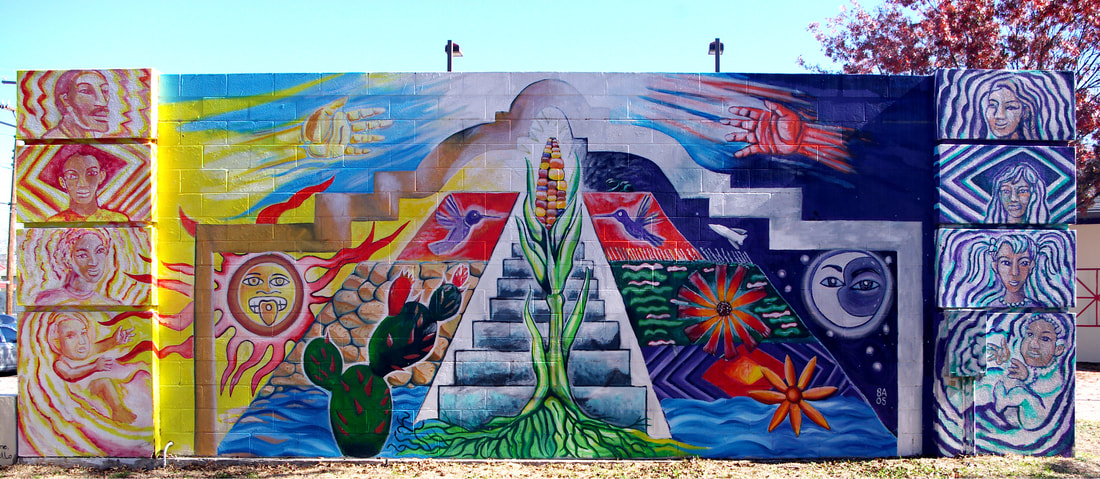#30 - Dualidad
|
Location: Plaza Avenida facing El Paso St.
Dimensions: 30' x 10'7" Date: 2005 Lead artist: Victor Ochoa (Muralist in Residence) |
This mural features classic chicano imagery. In the center, an Aztec temple grows behind a maíz stalk, with a nopal growing on one side and colibrís on either side. The title of the mural, which means duality, comes from the mural’s split night-and-day imagery. The right side shows the moon, with images of a girl growing into a woman. The left side shows the sun, with panels of a boy growing into a man. Two hands reach towards each other from either side of the mural as the two sides of this dualidad merge in the central figure of maíz, the plant that sustains life.
|
Victor Ochoa is a legendary chicano muralist based out of San Diego. He is perhaps most famous for being one of the original activists and artists at Chicano Park. San Anto Cultural arts founder and Executive Director Manny Castillo brought Ochoa in as one part of the Muralist in Residence Program (MIRP). Ochoa designed the mural and the mural crew used projectors to trace the design onto a whitewashed free-standing wall in the Plaza Avenida. After painting, artists began to fill in the drawing with paint. Cardee and Gerry Garcia worked closely with Ochoa, leading the team to finish Dualidad when he had to return to San Diego. |
|
|
History: Working with Children
Gerry and Cardee worked hard to incorporate youth in painting Dualidad, as with all their mural projects. Because both the Garcias grew up on the Westside, they understand the importance of arts programming for kids in the barrio. Cardee says:
We didn’t want them to look like chafa, half-done, or like nobody cared about them...We wanted them to look like we cared about what we were painting. Sometimes it’s hard because we have a lot of kid volunteers and a lot of them don’t know how to paint, but you don’t want them to be scared to get in there. So a lot of the process is also teaching how to paint and not just painting ourselves. So once we’re painting there with the kids it’s a lot of direction more than anything, and once it’s time for the kids to go we go in there and clean up a little bit, not to erase what they did but just make it look a little more presentable because we want them to see their work in there too.
Even though working with young artists can complicate and delay projects, the Garcias believe it is well worth the effort. Speaking about the value of community arts, Gerry says:
Anybody can do it. Kids can pick up a brush and say what they wanna say. We had community seniors helping out, it involved everybody. It was completely inclusive. The arts are one of the most fundamental human forms of communication...It transcends language, it transcends nationality. It’s all about getting your message across.


